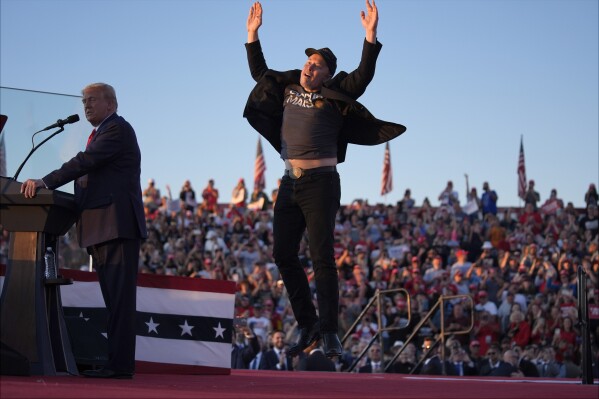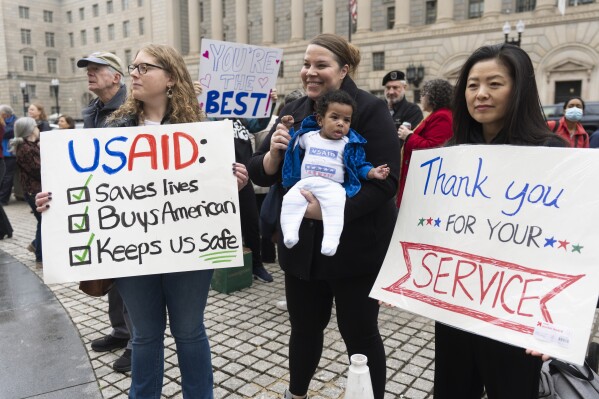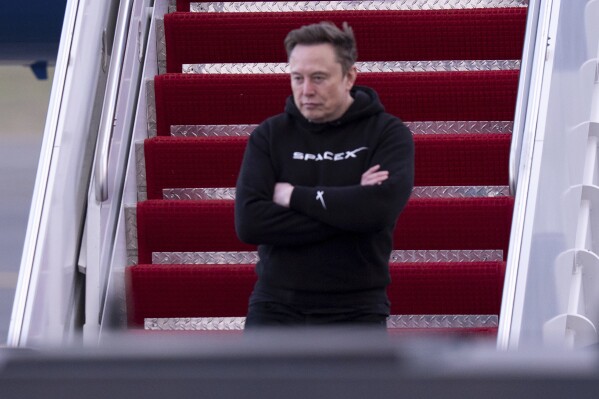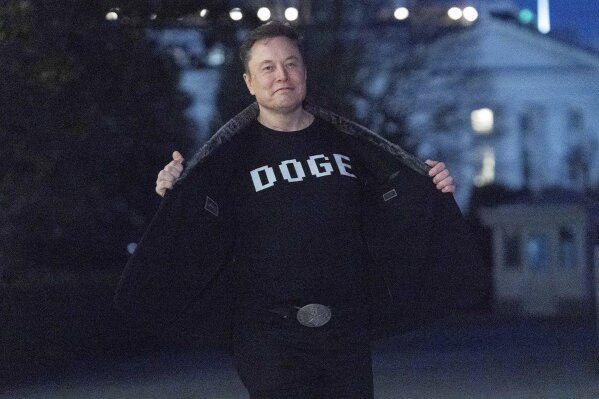Elon Musk arrived in the nation’s capital with the chainsaw-wielding swagger of a tech titan who had never met a problem he couldn’t solve with lots of money, long hours, or a well-calibrated algorithm.
President Donald Trump was delighted to have the world’s richest person — and a top campaign donor — working in his administration, talking about how he was “a smart guy” who “really cares for our country.”
Musk was suddenly everywhere — holding forth in Cabinet meetings while wearing a “tech support” shirt and black MAGA hat, hoisting his young son on his shoulders in the Oval Office, flying aboard Air Force One, sleeping in the White House. Democrats described the billionaire entrepreneur as Trump’s “co-president,” and senior officials bristled at his imperial approach to overhauling the federal government.
After establishing Tesla as a premier electric automaker, building rockets at SpaceX and reshaping the social media landscape by buying Twitter, Musk was confident that he could bend Washington to his vision.
Now that’s over. Musk said this week that he’s leaving his job as a senior adviser, an announcement that came after he revealed his plan to curtail political donations, and he criticized the centerpiece of Trump’s legislative agenda.
It’s a quiet exit after a turbulent entrance, and he’s trailed by upheaval and unmet expectations. Thousands of people were indiscriminately laid off or pushed out — hundreds of whom had to be rehired — and some federal agencies were eviscerated.
But no one has been prosecuted for the fraud that Musk and Trump said was widespread within the government. Musk reduced his target for cutting spending from $2 trillion to $1 trillion to $150 billion, and even that goal may not be reached.
In Silicon Valley, where Musk got his start as a founder of PayPal, his kind of promises are known as vaporware — a product that sounds extraordinary yet never gets shipped to market.
Trump said Thursday on his Truth Social platform that he would hold a press conference Friday with Musk. “This will be his last day, but not really, because he will always be with us, helping all the way,” Trump added. “Elon is terrific!”
Musk’s position was always designed to be temporary, and he had previously announced his intention to dedicate more of his time to his companies. But he also told reporters last month that he was willing to work part-time for Trump “indefinitely, as long as the president wants me to do it.”
Musk got a seat at Trump’s table and put $250 million behind his campaign

It was clear that Musk wouldn’t be the typical kind of presidential adviser around the time that he showed the world his belly button.
Racing on stage at a campaign rally one month before the election, he jumped for joy next to Trump, his T-shirt rising to expose his midriff. Musk had already sold Trump on his idea for a Department of Government Efficiency while also putting at least $250 million behind his candidacy.
The plan called for a task force to hunt for waste, fraud, and abuse, a timeworn idea with a new twist. Instead of putting together a blue-ribbon panel of government experts, Trump would give his top donor a desk in the White House and what appeared to be carte blanche to make changes.
Musk deployed software engineers who burrowed into sensitive databases, troubling career officials who sometimes chose to resign rather than go along. Trump brushed off concerns about Musk’s lack of experience in public service or conflicts of interest from his billions of dollars in federal contracts.
Their unlikely partnership had the potential for a generational impact on American politics and government. While Musk dictated orders for government departments from his perch in the White House, he was poised to use his wealth to enforce loyalty to the president.
His language was that of catastrophism. Excessive spending was a crisis that could only be solved by drastic measures, Musk claimed, and “if we don’t do this, America will go bankrupt.”
But even though he talked about his work in existential terms, he treated the White House like a playground. He brought his children to a meeting with the Indian prime minister. He let the president turn the driveway into a makeshift Tesla showroom to help boost sales. He installed an oversized screen in his office that he occasionally used to play video games.
Sometimes, Trump invited Musk to sleep over in the Lincoln Bedroom.
“We’ll be on Air Force One, Marine One, and he’ll be like, ‘do you want to stay over?’” Musk told reporters. The president made sure he got some caramel ice cream from the kitchen. “This stuff’s amazing,” Musk said. “I ate a whole tub of it.”
Looking back on his experience in government, he described it as a lark.
“It is funny that we’ve got DOGE,” an acronym that references an online meme featuring a surprised-looking dog from Japan. “How did we get here?”
Musk did not give federal workers the benefit of the doubt

From the beginning, Musk treated federal workers with contempt. At best, they were inefficient; at worst, they were committing fraud.
His team offered them a “fork in the road,” meaning they could get paid to quit. Probationary employees, generally people new on the job without full civil service protection, were shown the door.
Anyone who stayed faced escalating demands, such as what became known as the “five things” emails. Musk wanted every government employee to submit a list of five things they accomplished in the previous week, and he claimed that “failure to respond will be taken as a resignation.”
Some administration officials curtailed the plan, concerned that it could jeopardize security in more sensitive areas of the government, and it eventually faded, an early sign of Musk’s struggle to get traction.
But in the meantime, he continued issuing orders like thunderbolts.
One day in February, Musk posted “CFPB RIP,” plus an emoji of a tombstone. The headquarters of the Consumer Financial Protection Bureau, created after the Great Recession to protect Americans from fraud and deceptive practices, was shut down, and employees were ordered to stop working.
Musk had already started gutting the U.S. Agency for International Development, a pillar of the country’s foreign policy establishment and the world’s largest provider of humanitarian assistance.
“Spent the weekend feeding USAID into a wood chipper,” he bragged.
Thousands of contacts were cut off, pleasing conservatives who disliked the agency’s progressive initiatives on climate change and gay rights.
Musk rejected concerns about the loss of a crucial lifeline for impoverished people around the globe, saying, “no one has died.” However, children who once relied on American assistance perished from malnutrition, and the death toll is expected to increase.
The lawsuits began piling up. Sometimes workers got their jobs back, only to lose them again.
The Food and Drug Administration, which is responsible for ensuring the safety of everything from baby formula to biotech drugs, planned to lay off 3,500 employees. But again and again, the agency was forced to rehire people who were initially deemed expendable, including laboratory scientists, travel bookers, and document specialists.
Commissioner Marty Makary, who started his job after many of the cuts took place, told attendees at a recent conference that “it was hard and my job is to make sure we can heal from that.”
Only 1,900 layoffs took place, but another 1,200 staffers took buyouts or early retirement. Experts fear the agency has lost much of its institutional knowledge and expertise in areas like vaccines, tobacco and food.
There are also concerns about safety on public lands. The National Park Service has been bleeding staff, leaving fewer people to maintain trails, clean restrooms, and guide visitors. More cuts at the Forest Service could undermine efforts to prevent and fight wildfires.
The Environmental Protection Agency faces a broad overhaul, such as gutting the Office of Research and Development, which was responsible for improving air pollution monitoring and discovering harmful chemicals in drinking water.
Not even low-profile organizations were exempt. Trump ordered the downsizing of the U.S. Institute of Peace, a nonprofit think tank created by Congress, and Musk’s team showed up to carry out his plan. The organizations’ leaders were deposed, then reinstated after a court battle.
Musk made little headway at the top sources of federal spending

The bulk of federal spending goes to health care programs like Medicaid and Medicare, plus Social Security and the military.
Unfortunately for Musk, all of those areas are politically sensitive and generally require congressional approval to make changes.
Thousands of civilian workers were pushed out at the Pentagon, and Defense Secretary Pete Hegseth is reducing the ranks of top generals and looking to consolidate various commands. A plan to downsize an office for testing and evaluating new weapons systems could save $300 million per year. Hegseth recently asked employees to submit one idea per week for cutting waste.
However, the Pentagon budget would increase by $150 billion, for a total of more than $900 billion, under Trump’s spending proposal working its way through Congress. The money includes $25 billion to lay the groundwork for Trump’s “golden dome” missile defense program and $34 billion to expand the naval fleet with more shipbuilding.
Another $45 million is expected to be spent on a military parade on June 14, which is the 250th anniversary of the Army’s founding and Trump’s 79th birthday.
Musk also faced blowback for targeting Social Security, which provides monthly benefits to retirees and some children. He suggested that the popular program was “a Ponzi scheme” and the government could save between $500 billion and $700 billion by tackling waste and fraud.
However, his estimates were inflated. Social Security’s inspector general said there was only $71.8 billion in improper payments over eight years. Nor was there any evidence that millions of dead people were receiving benefits.
Changes to Social Security phone services, pitched as a way to eliminate opportunities for fraud, were walked back after an outcry from lawmakers and beneficiaries. But the agency could still shed 7,000 workers while closing some of its offices.
Musk’s popularity cratered even though Americans often agreed with his premise that the federal government is bloated and wasteful, according to polling from The Associated Press-NORC Center for Public Affairs Research.
Just 33% of U.S. adults had a favorable view of Musk in April, down from 41% in December. In addition, 65% said Musk had too much influence over the federal government.
Musk talked of staggering savings but delivered modest results

During a campaign rally in October, Musk said he could find “at least $2 trillion” in spending cuts. In January, before Trump was inaugurated, he revised by saying, “if we try for $2 trillion, we’ve got a good shot at getting one.”
But in April, at a Cabinet meeting, Musk provided a different target. He was “excited to announce” that they could reach $150 billion in savings during the current fiscal year.
Whether that figure proves to be accurate is difficult to measure, especially because DOGE routinely inflated or mischaracterized its work. But it falls short of President Bill Clinton’s initiative three decades ago, which resulted in $136 billion in savings — the equivalent of more than $240 billion today.
Elaine Kamarck, a key figure in the Clinton administration, said they focused on making the government more responsive and updating antiquated internal procedures. The work took years.
“We went about it methodically, department by department,” she said. The effort also reduced the federal workforce by more than 400,000 employees.
However, Musk did little to seek insight from people who knew the inner workings of government.
“They made some changes without really knowing what they were doing,” said Alex Nowrasteh, vice president for economic and social policy studies for the libertarian think tank Cato Institute. He said there were “a lot of unforced errors.”
In the end, Nowrasteh said, “They set themselves up for failure.”
Tech billionaire Elon Musk officially announced Wednesday that his time as a top adviser in the Trump administration has come to an end.
His departure from the Department of Government Efficiency marks the end of a bumpy chapter that included thousands of layoffs of federal employees, the shuttering of various agencies and a firestorm of challenges both in the courts and at his companies.
Musk took a leading role in the administration with promises to reduce wasteful government spending and end the “tyranny of bureaucracy.” As he leaves his post to return focus to his business ventures, was he successful with his goals for DOGE?
Musk’s departure
Musk has been leading the department since President Donald Trump’s inauguration day in January as a “special government employee.”
A special government employee is someone within the executive branch or federal government who is appointed to serve for a period not exceeding 130 days during a period of 365 consecutive days, meaning Musk’s tenure at DOGE would come to an end around this time.
Musk shared earlier this month during a Tesla earnings call that his time allocation to DOGE would “drop significantly” as shares have fallen this year at Tesla and he shifts focus to his rocket company SpaceX.
At first, it was unknown when Musk would take a step back from his position with DOGE, but he announced Wednesday on X, the social platform he owns, that his scheduled time as a special government employee was coming to an end.
“I would like to thank President @realDonaldTrump for the opportunity to reduce wasteful spending,” Musk wrote. “The @DOGE mission will only strengthen over time as it becomes a way of life throughout the government.”
Musk, the world’s richest person, rose to political fame over the last year after spending at least $250 million on Trump’s 2024 campaign. His influence grew after being appointed to lead DOGE, and he was viewed as a key player in Republican Party politics.
However, his efforts to influence the Wisconsin Supreme Court race in April did not pan out. Musk spent at least $3 million of his own money to elect the conservative candidate, gave out $1 million checks through his America PAC, and spent more through various groups, but the state elected the liberal candidate in the race, dealing a political blow to Musk.
In May, Musk said he would be spending a “lot less” on political campaigns in the future than he did before, saying he thinks he’s “done enough.” He also criticized the Trump-backed “big, beautiful bill.”
Spending and workforce cuts
One of Musk’s leading goals was to reduce federal spending. Musk and DOGE acted at lightning speed to enact changes across agencies and departments, leaving Congress scrambling to keep up and workers wondering if they would be cut next.
While Musk celebrated DOGE’s cuts to the federal budget, critics said the savings came at a price, and watchdogs question the numbers, reasoning ,and logistics behind DOGE’s reporting.
Musk first promised to cut spending by $2 trillion, which he later reduced to $1 trillion and then down to about $150 billion, The Associated Press reported.
As of May 26, DOGE shared it saved an estimated $175 billion through a combination of asset sales, contract and lease cancellations, fraud and improper payment deletion, programmatic changes, workforce reductions and more.
DOGE said it has saved the average taxpayer $1,086 through the cuts, its website said. However, DOGE has not said where the remaining spending cuts would come from, and a BBC analysis in April found just $61.5 billion of the total savings were itemized so far.
Despite Musk and Trump insisting the administration would cut back on Biden-era spending, a CBS News report found the government spent over $200 billion more in Trump’s first 100 days compared to 2024 spending.
According to a New York Times analysis of layoffs, nearly 60,000 federal workers have been laid off. About 76,000 took DOGE’s buyout offer, and nearly 150,000 more are expected to be impacted by reduction plans for the federal workforce.
Some of the largest cuts come from DOGE’s dismantling of the U.S. Agency for International Development, Voice of America, AmeriCorps, the Consumer Financial Protection Bureau and the Department of Education, the analysis found.
DOGE said on its website that it terminated nearly 500 real estate leases, totaling $216 million in savings. Nearly 50 Social Security Administration offices are expected to close within the year, even as the agency looks to require in-person identity checks in field offices for new and existing beneficiaries, with some exceptions. The changes will require people to make more trips to understaffed field offices, a new study found.
Legal challenges
While Musk and DOGE have faced fierce pushback from Democrats in Congress and protesters across the country for the cuts, several of the department’s actions have held up in court.
According to a New York Times roundup of legal dockets, there are more than two dozen open cases against Musk and DOGE’s actions, over various issues including shuttering the U.S. Institute of Peace, the department gaining access to Americans’ data and the American Privacy Act, mass layoffs and more.
The legal battles have already begun to play out in the courts.
Thousands of people fired by DOGE earlier this year were reinstated in February after a court order, but later decisions from the Supreme Court and an appeals court blocked the lower court ruling that would have reinstated the workers.
Some of Musk’s critics are pointing to the legal battles as a reason for him leaving the administration, noting how the cases are setbacks to DOGE’s efforts.
What people are saying
Musk’s departure from the administration was largely uneventful after he shared the news online later Wednesday.
Sources familiar with the matter confirmed to Reuters that Musk’s “off-boarding” process began Wednesday evening, and the tech CEO did not have a formal conversation with Trump before his announcement. Musk’s departure was decided at “a senior staff level,” Reuters reported.
Musk and Trump are expected to hold a press conference together on Friday.
The Trump administration and GOP allies insist that Musk’s effort to downsize the government was effective.
White House press secretary Karoline Leavitt addressed Musk’s departure during Thursday’s press briefing, saying the administration thanks him for his service and “getting DOGE off the ground.”
The department’s efforts to cut “waste, fraud, and abuse will continue,” Leavitt said.
Utah Sen. Mike Lee shared several posts online praising Musk’s time in the administration. Lee thanked Musk for his service and said he was “confident” that Musk’s critics would live to see him “proven right.”
“Thank you for everything you have done, and will continue to do, for our country, Elon,” Lee said in a separate post. “This is just the beginning.”
Musk’s critics also weighed in on his step back from the administration.
Former White House ethics czar Norm Eisen dismissed the idea that Musk was retreating from DOGE because his 130-day timeline as a special government employee was up. Eisen argued that the legal battles facing Musk and DOGE were the real reason he is leaving his post.
“Give me a break, Musk is not leaving because his scheduled time is up,” Eisen shared Wednesday on BlueSky. “The litigation held him accountable, & for that & other reasons he became politically unpopular & a liability.”
Attorney and fierce Trump critic George Conway agreed with Eisen, noting that the 130-day limit “just happened to be the one law” Musk complied with. Conway said Musk clashed with the courts, and his public opinion of him dropped, saying, “Good riddance.”
After posting his farewell message on Wednesday, Musk spent Thursday posting on X about his other business ventures, including Tesla, SpaceX, and X’s AI tool grok.
The nation’s capital had never seen anyone like Elon Musk, who announced this week that he’s stepping back from his role as Donald Trump’s most unorthodox adviser.
Musk, the world’s richest person in the world, had an outsized role leading the Department of Government Efficiency as it canceled contracts and slashed the federal workforce. Musk says he’s moving away from political activity to refocus on his businesses, such as electric automaker Tesla and rocket company SpaceX.
This is a photo gallery curated by AP photo editors.

.webp)
.webp)
.webp)
